Kia Carens: Lane Departure Warning System (LDWS) / Description and operation
System Operation
Typically, lane departure warning is activated at a speed over 60 km, in case
of unintentional lane departure when driver do not operate turn signal.
System Operation Conditions
| 1. |
User Conditions
| (1) |
When unintended lane departure is occured, warnings are generated.
|
| (2) |
When driver operates a turn signal for lane departure, no warnings
are generated.
|
|
| 2. |
Vehicle Conditions
| (1) |
When the accelerated velocity of vehicle exceeds certain speed,
LDW system is activated.
|
| (2) |
When a turn signal is not used. LDW system activates.
|
|
| 3. |
Lane Conditions
| (1) |
lanes are visible and recognizable, LDWS can be on normal operation
mode.
|
| (2) |
Operate on all roads, including highways, country roads and
urban freeways at a speed of 60 km/h and from 2.5 to 5.0 meters
of lane width.
|
| (3) |
Lane material: asphalt roads, concreat roads
|
| (4) |
Lane color: White, Yellow, Blue,
|
| (5) |
Temporary lane marker for repairing road
|
| (6) |
lanes are visible and recognizable, LDWS can be on normal operation
mode independent of season or time,
|
| (7) |
Operate under partially visible lane markers, but may not operate
under severe weather (ex. Heavy rain)
|
| (8) |
Be performed in a curve of radius 250 meters
|
|
Lane Departure Warning
This lane Departure Warning Algorithm is for HKMC whole vehicle that will apply
to LDWS
| 1. |
Lane departure warning start speed: 60KPH
| (1) |
Warning Start Speed: 60KPH
|
| (2) |
Warning Stop Speed: 55KPH
|
To prevent repetition of system warning on and off according to vehicle
speed variation, This specification establish warning stop speed as
55 KPH for hystheresis characteristic.
|
| 2. |
Lane Recognition Standard Speed : 40KPH
| (1) |
Lane recognition start speed : 40KPH
Lane recognition is started at 40KPH less than warning start
speed to minimize recognition time after vehicle is drived into
lane.
|
| (2) |
Lane recognition stop speed: 35KPH
Lane recognition stop speed is setted 35KPH with hysteresis
to avoid repetition of lane recognition on and off.
|
| (3) |
Cluster can not display lane recognition even if lane detected,
cluster display lane recognition when operation speed is more
than 60KPH.
|
|
| 3. |
Warning Method
| (1) |
Warning Device
Cluster, Buzzer
|
| (2) |
Cluster Display Symbols
|
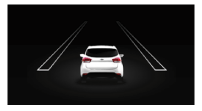
|
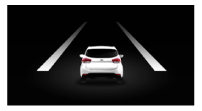
|
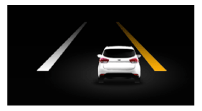
|
Lane not detected
|
Lane detected and warning system engaged
|
Right side deviation
|
|
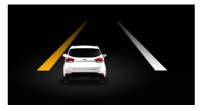
|
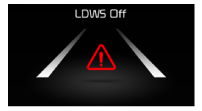
|
|
Left side deviation
|
System malfunction
|
※ Display symbol and period vary according to vehicle's LCD
and alarm.
(It is possible to adjust blinking period.)
|
|
Lane Type
LDW System can recognize a full lane, a dotted lane, Bott’s Dot and yellow
Retroreflective on a road.
In case of double lane, LDW System can recognize the lane on the inside. This
is a standard about a dotted lane.
Recognition of Double Lane
In case of double lane, LDW System can recognize the lane on the inside.
Determination of Lane Departure
Lane Departure is determined according to vehicle speed, lane width and color.
LDW System set lane recognition error limits under 8cm.
| 1. |
Lane width (L)
If Lane width is 2.5 ~ 5.0m (Including North America standard) then
departure warning is activated.
|
| 2. |
Line painted width (p)
Line painted width is refered to 16cm (the minimum 10cm, the maximum
55cm). LDWS can distinguish left,right lane color. If it is technically
possible, LDWS can distinguish kind of lane such as solid and dot.
|
| 3. |
Vehicle Width (W)
Vehicle width is defined by kind of vehicle. Vehicle width is stored
in internal memory and can be written by In-line tool using WriteDataByLocalIdentifier
command or vehicle project code
|
| 4. |
Lane Departure Warning Standard of Left Yellow Lane (Central Lane)
| – |
condition 1 : Gap between yellow lane and a median strip is
25cm.
→ In case of road limit speed less than 80KPH, The distance
between central lane and lane designs 25cm
|
| – |
condition 2 : Yellow line width is 16cm as same line painted
width.
|
| A. |
Central lane Departure Warning
Central lane departure warning is activated when Vehicle’s
tire reachs to lane.
|
| B. |
Cancellation of Central lane Departure Warning
When the vechicle departs the lane toward opposite lane more
than 40% of the lane width, the warnings are deactivated.
|
|
| 5. |
Left,Right normal Lane (Blue, White, Right Yellow)
Condition : Lane width standard is a 16cm.
| a. |
1st Lane Departure Warning
The departure alarm of the general lane when the wheel of the
vehicle reaches to the lane, does in standard.
|
| b. |
Cancellation of lane departure warning
When the vechicle departs the lane toward opposite lane more
than 40% of the lane width, the warnings are stopped.
|
|
| 6. |
The case of recognizing one of two lines (lane)
The case of recognizing one of two lane, system provide departure warning
using one line.
|
Lane Departure Warning Deactivation
| 1. |
Turn signal is actived
| a. |
Depart from lane after turn signal is activate
If vehicle departs from lane after turn signal is activated,
the departure warning of turn sigal direction is not activated.
If vehicle departs from opposite line of turn signal direction,
Departure warning is activated. Warning alarm is not activated
while turn signal is activated. If turn signal is deactivated
during lane departure after turn signal activates, system can
issue warning after 2sec when it can recognize lane.
If turn signal is deactivated after lane departure during turn
signal activated, Warning signal can be generated after 2 second.
|
| b. |
Turn signal is activated after lane departure
Alarm is immediately deactivated when driver operates turn signal
during lane departure.
Alarm can be activated again after 2 second when turn signal
is deactivated.
|
|
| 2. |
Tracking on a curve under 250m radius
When measured curve radius which is derived from lane recognition and
Yaw Rate is under 250m,
LDWS do not warn lane departure. LDWS can recognize if a road curvature
condition is under 250m
(R >= 250m)
|
| 3. |
Lane is unrecognizable
| a. |
During the warning, lane becomes unrecognizable
|
| – |
In lane departure alarm, the case where one lane becomes unrecognizable:
Alarm is activated using previously measured lane width, a hue
and a curvataure.
|
| – |
In lane departure alarm, the case where both lanes become unrecognizable:
Lane departure Warning is immediately stopped and LDWS signal
that lanes are unrecognizable to warn its condition to driver.
|
| b. |
A line is unrecognizable
During vehicle is tracking the lane, if a line is not recognizable,
LDWS can excute lane departure warning using previous lane width
which is measured from previous image processing. LDWS normally
refer the color of lines to previous recognition result, but
if there are any changes of system operation and power on/off,
when system can not determine the color of the lane, system
can excute lane departure warning algorithm refer lane color
to white. When system line unrecognized state is maintained,
System status is changed to line unrecognized state.
|
| c. |
Both lanes are unrecognizable
LDWS signal the status of unrecognizable lane. If there are
none of additional indicator, system do not indicate recognition
status.
|
|
LDWS is capable of recognizing continuing lines as lanes and
has limited lane recognition capabilities when it comes to sharp-bending
roads.
In addition, the system may not function properly under the
following circumstances:
| –
|
No or faded lane markings (failed lane detection).
|
| –
|
Low visibility due to foul weather conditions.
|
| –
|
Low light or sudden change in exterior light conditions.
|
| –
|
Sharp bends of the road (curvature radius of less than
250m).
|
| –
|
Sidewalks and other dividing structures along the edge
of the lane.
|
| –
|
Dirty windshield (low camera visibility).
|
|
|
Camera Calibration
| 1. |
Necessity
Once installed to the vehicle, LDWS needs to be calibrated to achieve
accurate lane marking recognition.
Specifically, the system needs to be calibrated to correct any difference
between the ideal road coordinates and the actual road coordinates.
| – |
When replacing the lane departure warning system unit.
|
| – |
When repairing the roof panel of chassis by vehicle crash.
|
| – |
When repairing the LDWS unit mounting bracket
|
| – |
The system need to be calibrated to corect any vehicle crash.
|
|
| 2. |
Schedule
Calibrate after LDWS replacement and as necessary.
| – |
Condition : There should be an error between ideal road coordinates
and actual road coordinates after installing the LDWS unit.
|
| – |
Object : Calibrate an error in LDWS unit to improve coordinates
accuracy.
|
| – |
Procedure : Operate the calibration procedure using the GDS
and calibration target jig.
|
| – |
Environment : Vehicle on an even surface and align the center
of target jig to down the degree of scattering.
|
| – |
Calibration process : Refer to bellow "Calibration procedures"
|
|
Calibration Procedures
|
Check LDWS lens vision field and if the lens is dirty, make it clean.
|
| 1. |
Set the calibration target jig (09890-3V100) height as below illustration.
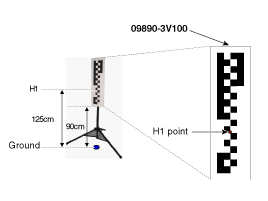
|
| 2. |
Set the calibration target jig (09890-3V100) and align the center of
target with center line of vehicle as below position. (L1-L2 = 10cm)
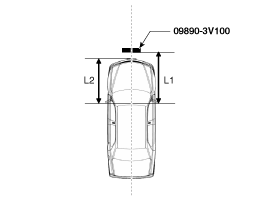
|
| 3. |
Connect GDS to the vehicle to calibrate LDWS unit.
|
| 4. |
Select model and LDWS system.
|
| 6. |
Operate calibration automatically.
|
| 7. |
Select "LDWS Reference Point Calibration" and complete calibration procedures.
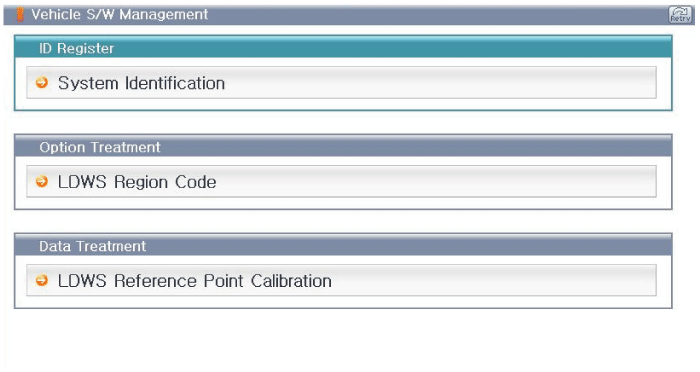
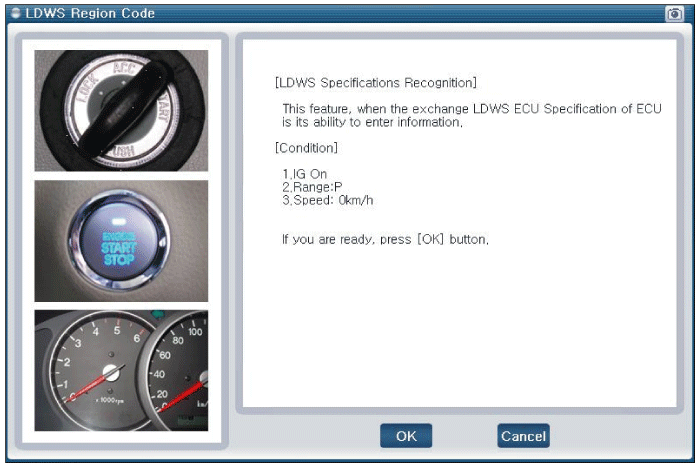
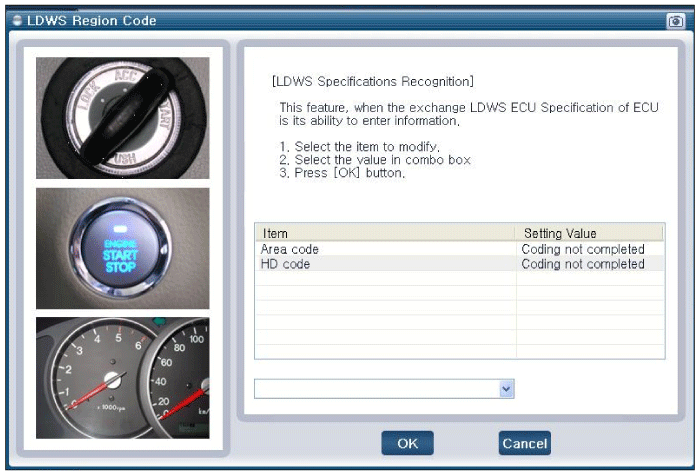
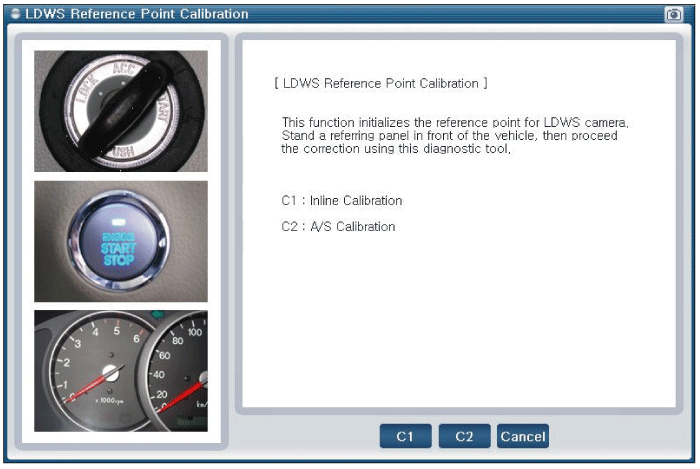
|
Components
1. LDWS ON/OFF switch
2. Instrument cluster
3. LDWS unit
...
Other information:
✽ NOTICE
If, for some reason, you happen to lose your smart key, you will not
be able to start the engine. Tow the vehicle, if necessary, we recommend that
you contact an authorized Kia dealer.
A maximum of 2 smart keys can be registered to a single vehicle. If you
lose a smart key, we re ...
Components
1. Clutch release fork
2. Clutch cover assembly
3. Clutch disk assembly
4. Clutch release bearing
...
 Components and components location
Components and components location














